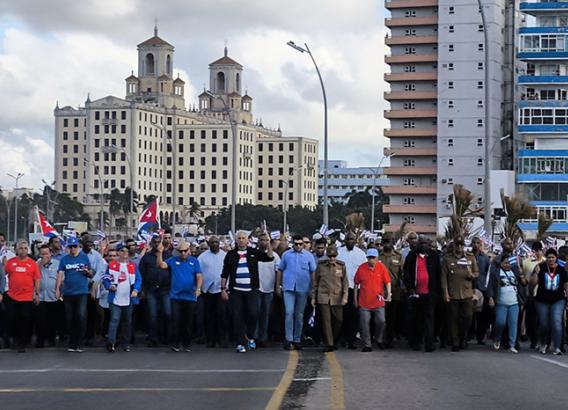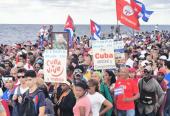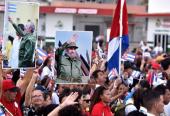The Tale of GAESA
especiales

The relentless quest to find a motive, a pretext to intensify the multifaceted economic war against Cuba, is currently producing the kind of pseudo-journalistic investigations where fantasy surpasses reality. The U.S. Secretary of State, Mr. Rubio, in barely concealed desperation, has urged an increase in media actions that could serve as a pretext to obstruct, or even halt, any flow of economic and financial resources, in line with further tightening the blockade against the Cuban people.
Naturally, this mission could not proceed without the inescapable involvement of a journalist of distant Cuban origin, Nora Gámez, who published a story in a Florida-based outlet, the Miami Herald, a publication of regrettable reputation for its tendency to give space to any absurdity that might serve to discredit the Revolution. There is little point in speaking about Gámez herself, since she exposes herself through her own work, but rather about what she published, asserting that the Cuban Grupo de Administración Empresarial SA (GAESA) is hoarding vast financial resources.
Cuban economists have swiftly demonstrated, with a brief examination of the figures presented in the Herald, the degree of fabrication in Gámez’s invented numbers. To begin, consider the quantity itself. The writer claims that GAESA accumulated and stored 18 billion USD under the mattress in 2023 alone. Yet that year, Cuba’s total exports amounted to 8.5 billion USD. The first question is obvious: could this single conglomerate alone have doubled the exports of an entire country?
Moreover, one of the most recognized economists of the Cuban counterrevolution acknowledged that these numbers were impossible to verify, calling them conjectural and of a phantasmagorical nature. Interpret these disqualifications as you will, but it is evident that no serious observer can believe such figures.
The absurdity does not end there. As is customary in such narratives, the claim is paired with assertions that stores operating in freely convertible currency (MLC) and the tourism sector have suffered a colossal collapse, plunging into freefall. GAESA holds a significant presence in both sectors, so how could it possibly have increased its revenues to the level alleged by Gámez if two of its most valuable business areas are in crisis? Even more illogical, why would GAESA, with so much money, neglect two sectors that are repeatedly described as failing, yet if well managed could be highly profitable?
Another glaring inconsistency is that, if Gámez’s figure were accurate, it would place GAESA among the world’s 600 most profitable companies, ranked 563rd, just below Nestlé. Right after GAESA would appear the globally recognized insurance multinational MAPFRE and the well-known software company Adobe. Can anyone seriously believe this?
Here another point emerges, which Gámez clearly overlooked. Under these assumptions, one would be demonstrating that the Cuban socialist state enterprise model not only works, but outperforms major global monopolies. Yet the prevailing narrative insists that this model is a failure. Without intending to, Gámez has contradicted hundreds of campaigns attacking the inefficiency of the socialist state and Cuban state enterprises. Perhaps the ideologues of MAGA have not read the article, lest they consider deporting her for praising communist ways of organizing the economy.
If all this were not enough, the most laughable aspect is the source of the statistics published in the Herald. Gámez, in what can only be described as Agatha Christie on steroids, claims she obtained the data from an unusual leak of secret military documents, giving the article that gullible bait aura of mystery and conveniently ensuring that the sources cannot be verified. By now it should be obvious that credibility is not Gámez’s strong suit.
It is clear that the unveiling of this Agatha Christie/Gámez investigation serves several purposes, with little to no regard for credibility. The goal is to disparage Cuban economic institutions, undermining them in the eyes of both domestic and international opinion by suggesting that, while they supposedly hoard wealth for no reason other than sheer pleasure, the rest of the Cuban population endures severe hardship. The story also speculates that the country’s armed forces should not be managing economic sectors, among other arguments.
In her instructive attempts with a pretense of news originality, Gámez ignores that she is spinning this tale from perhaps the least credible place to question the role of a supposed military conglomerate in a nation’s economy. In fact, one does not need an unusual leak of secret military documents to discover the role played by the U.S. military-industrial complex. The Bureau of Economic Analysis (BEA), an agency of the U.S. Department of Commerce, estimates that this complex, together with so-called new technology companies, which often operate in close connection, accounts for no less than 12.5 percent of GDP, about 2.3 trillion USD. Furthermore, it is conservatively estimated that around 60 percent of the top executives and major shareholders of this military-industrial complex also control civilian energy, commerce, media, and finance companies, among others.
There are many examples, one of the most significant being that of BlackRock, Vanguard, and State Street, the largest shareholders in the so-called Big Five defense contractors (Lockheed, Raytheon, etc.) who also dominate companies such as Apple, Google, and Walmart. It would even be interesting for Gámez to inform her readers whether the investment fund Chatham Asset Management, which controls the Miami Herald, has any link to the aforementioned military-industrial complex. In that case, she would not have to wait for indiscreet secret sources, but could simply ask from the very newsroom where she collects her paycheck.
It should also be noted that if in 1990 the wealthiest 1 percent of Americans held 15 percent of the nation’s wealth, that figure had risen, unsurprisingly, in their favor to 34 percent by 2024. It is not in Cuba, Ms. Gámez, but in the United States where there is a concentration of wealth and power rooted in military-oriented structures, which, to speak plainly, are the real owners of the country.
The most bizarre chapter of this serialized melodrama, as expected, came with the reaction of another familiar group, the usual suspects, namely Congress members Díaz-Balart, Giménez with a G, and of course, Ms. Salazar, all in unison demanding a tougher blockade because of GAESA’s excesses, invented by Gámez, or more accurately, scripted by Mr. Rubio for this improvised political drama.
To cap it off, in a state of political delirium, these anti-Cuban legislators demand that the U.S. government freeze those 18 billion USD, wherever they are supposedly stored, without leaving a single cent at room temperature. Imagine that, trying to freeze something that does not exist.
While cheerfully participating in this spectacle, these same legislators neglect the plight of thousands of migrants, who do exist, and who are subjected to the arbitrariness of a policy that blames them for the structural decline of the country.
In truth, there is little novelty in this low-budget operation. The modus operandi is as predictable as it is obvious: first they invent a cause, then they condemn it, then they use it as a pretext to tighten the blockade, and finally they blame the Cuban government for the consequences of that aggression.
In summary, the offensive against GAESA is just another episode in the parallel universe of the counterrevolution. Yet this time they have broken the mediocrity meter, and in their rush to serve Mr. Rubio, none of them took the trouble to apply basic arithmetic or elementary logic. Keep it up, the Cuban people know the truth, the rest is cosmic dust.
Translated by Sergio A. Paneque Díaz / CubaSí Translation Staff













Add new comment